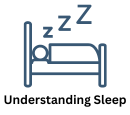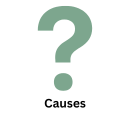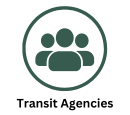Fatigue Resources for Transit Operations
To support the transit industry, FTA has compiled resources that can be used to better understand fatigue and fatigue-related issues in the workplace.
- Being awake for 17 hours is similar to having a blood alcohol concentration (BAC) of 0.05 percent.
- Being awake for 24 hours is similar to having a BAC of 0.10 percent.
Under FTA and U.S. Department of Transportation regulations, transit employers must prohibit covered employees from performing safety-sensitive functions while having a BAC of 0.04 percent or greater.
In 16 of 22 studies reviewed by the National Institute for Occupational Safety and Health (NIOSH), overtime was associated with poorer perceived general health, increased injury rates, more illnesses, and/or increased mortality. Overtime was also associated with unhealthy weight gain, increased alcohol use, increased smoking and poorer neuropsychological test performance. Working long hours led to deteriorating performance on psychophysiological tests as well as more injuries.
Source: Overtime and Extended Work Shifts: Recent Findings on Illnesses, Injuries, and Health Behaviors (NIOSH / CDC) | How Sleep Works: Understanding the Science of Sleep (Sleep Foundation)
All humans need sleep and a lack of sleep leads to fatigue. FTA has gathered the following resources to support the transit community in understanding and addressing fatigue in the workplace.
Fatigue Resources for Transit Operations
Click below to see a list of resources

Understanding Sleep
| Title | Description | Source |
|---|---|---|
| How Sleep Works: Understanding the Science of Sleep | An introduction to what happens to the mind and body during sleep. | Sleep Foundation |
| How Much Sleep Do You Need? | Recommended number of hours of sleep and tips to improve sleep quality. | Sleep Foundation |
| Improve Sleep: Tips to Improve Your Sleep When Times Are Tough | Nine evidence-based suggestions to improve sleep. | Centers for Disease Control and Prevention |
| Your Guide to Healthy Sleep | What activity is so important that you should devote approximately 1/3 of your time to doing it? Sleep! Learn about types of sleep, what makes you sleep, how much sleep is enough, common myths, disruption factors, common sleep disorders and more. (Free Download) | National Institutes of Health |
| Sleep & Health Education Gateway | Short videos and articles on healthy sleep, getting sleep, insomnia, apnea, and narcolepsy. | Harvard Medical School, Division of Sleep Medicine |
| Be Your Best Slept Self | Articles on a variety of topics, including basics of sleep and healthy sleep habits. | National Sleep Foundation |

Causes
| Title | Description | Source |
|---|---|---|
| Physiology of Fatigue: Causes and Effects | Information on possible causes of fatigue as well as some of the effects. Causes include time of day, sleep deprivation, time on task, personal factors, and work factors. Effects discussed are cognitive performance, work performance, safety performance, health consequences, and economic consequences. | National Safety Council |
| Effects of Driver Task-Related Fatigue on Driving Performance | A study of highway driving conducted via driving simulators, which concluded that both sleep-related fatigue (time of day, sleep disorders, sleep deprivation, etc.) and task-related fatigue (high traffic density, poor visibility, monotonous environments for extended periods of time, etc.) impacts driver performance. | Social and Behavioral Sciences |
| Plain Language About Shiftwork | Shift workers and night workers are often tired because of their work schedules. This article provides basic facts about shift work and suggested coping strategies. | Centers for Disease Control and Prevention |

Symptoms and Warning Signs
| Title | Description | Source |
|---|---|---|
| What are the signs of fatigue? | Watch out for these common signs and symptoms of fatigue. | Canadian Centre for Occupational Health and Safety |

Effects
| Title | Description | Source |
|---|---|---|
| Presentation: Improving the Health and Safety of Transit Workers with Corresponding Impacts on the Bottom Line | Medical costs for transit workers are consistently more than those for the general population. Some agencies have developed programs to mitigate negative health and safety outcomes. | Transit Cooperative Research Program |
| Report: Improving the Health and Safety of Transit Workers with Corresponding Impacts on the Bottom Line | This report addresses the prevalence of health and safety issues in the transit workforce, reviews costs associated with these health conditions, and analyzes results of wellness promotion programs. (Free Download) | Transit Cooperative Research Program |
| NSC Employer Cost Calculator Fatigue | Online tool to calculate real costs of fatigue in the workplace. | National Safety Council |

Transit Workers
| Title | Description | Source |
|---|---|---|
| How Employees Can Get Better Sleep | Four actions employees can take to improve sleep and reduce the risk of fatigue. | National Safety Council |
| CMV Driving Tips – Driver Fatigue | Six tips for staying healthy and well-rested while driving. | Federal Motor Carrier Safety Administration |
| Railroaders’ Guide to Healthy Sleep | Similar to railroaders, many transit employees work in a 24/7 world, performing their duties day and night. Check out the Railroader’s Guide to Healthy Sleep for a sleep toolkit, tips for family and friends, and information about exploring, improving and balancing sleep. | Federal Railroad Administration |

Transit Agencies
| Title | Description | Source |
|---|---|---|
| Fatigue at Work Employer Toolkit | Includes posters, fact sheets, safety talks, infographics, checklists, sample policies, and online trainings. (Requires users to provide contact information to access.) | National Safety Council |
| Presentation: Fatigue Awareness for Transit Operations | Provides training slides about fatigue, including signs, symptoms and effects. | Center for Urban Transportation Research, University of South Florida |
| Understanding Fatigue Risk: Assessment and Countermeasures | Appendices include an operational needs assessment to investigate workplace sources of fatigue and an employee survey to identify employee habits that may introduce fatigue such as sleep schedules. | Campbell Institute and National Safety Council |
| Toolbox for Transit Operator Fatigue | This toolbox is designed to provide resources and ideas for Agencies to consider when developing their own unique fatigue program. Examples of tools provided include the sleep debt index, personal alertness predictor, exercise basics, adjusting to shiftwork, analyzing and creating runs and investigating accidents. | Transit Cooperative Research Program |
| A Comprehensive Approach for Managing Commercial Driver Fatigue | A no-cost, fully interactive web-based education and training program developed to provide an awareness of the factors contributing to fatigue for truck and bus drivers. | North American Fatigue Management Program |

Fatique Risk Management Systems
| Title | Description | Source |
|---|---|---|
| Fatigue Management Program Requirements | Standards for rail transit systems to establish fatigue management programs. | American Public Transportation Association |
